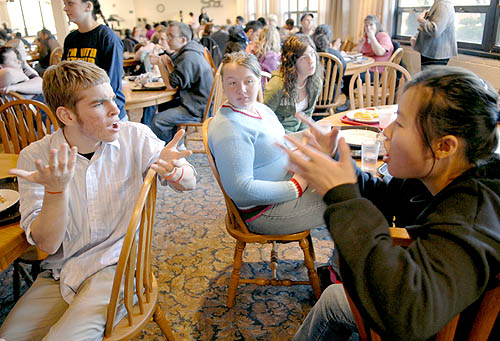Deaf students from Australia let their hands do the talking to teens here
Signs of friendship
Monday, December 03, 2007
By Eleanor Chute, Pittsburgh Post-Gazette

Photo by Steve Mellon/Post-Gazette
Adam Duty, left, a 16-year-old 11th-grade student at the Western Pennsylvania School for the Deaf, uses sign language to communicate with Shirley Liu, 15, a 10th-grade student visiting from Australia, during lunch period at the Edgewood school on Thursday. The United States and Australia use different forms of sign language, which complicates communication. In the center is Hayley Pickup, 15, also from Australia.
Fingers have been flying at the Western Pennsylvania School for the Deaf, where students are engaged in their first-ever international exchange.
Fourteen high school students from Australia’s Royal Institute for Deaf and Blind Children in Sydney are visiting this week and next; 12 American 11th-graders will visit them in Australia in March.
Donald Rhoten, superintendent of the local school, said school officials believe this international exchange is “the first of its kind anywhere.”
Even though they are all from English-speaking countries, the two groups of students communicate with different sign languages. The local students use American Sign Language, known as ASL, and the visitors use Australian Sign Language, also known as Auslan.
The big smiles on the faces of many students were in a universal language.
The deaf and hard-of-hearing teens are learning each other’s sign language as fast as they can sign as they compare food, prices, clothes and customs. A few of them also use speech.
Auslan uses two hands for each letter of the alphabet while the ASL uses one hand, explained Ashlyn Goforth, 16, of Monroeville, whose ASL words were translated into spoken words by her creative writing teacher, Cassie Beveridge.
Ashlyn said the American words sometimes incorporate the letter shapes, but the Australian ones are more likely to rely on gestures.
There can be some confusing ones. The sign for “where” in ASL — a fist with an index finger extended — is the same as the sign for “what” in Auslan.
And if someone makes circles around an ear, which some Americans might think means someone is crazy, that means “yellow” in Australian sign language.
The differences didn’t seem to slow them down. They learned some of each other’s language before arriving. At the school, they kept up a quick pace as they worked on a shape poem in class — for one team of students, it was words making a poem pasted on the shape of lips — and bantered at lunch.
It seemed as if almost any communications barrier could be jumped.
Here’s how Shirley Liu, 15, of New South Wales, Australia, told a hearing person who doesn’t know any sign language about her stay:
Shirley signed in ASL where she could and in Auslan where she couldn’t. Ms. Beveridge understood part of it, and Ashlyn, who is picking up Auslan, signed in ASL to Ms. Beveridge to fill in the gaps. Ms. Beveridge then translated the remarks into the spoken word.
What Shirley said was: “I’m really enjoying it here. I’m learning a lot of new signs and learning about everything here.”
Shirley is particularly impressed by the technology available at the school.
Meanwhile, Ashlyn said she’s excited about the visitors and her opportunity to go to Australia next year.
“I’m curious to go to another country, to go far from my home,” she signed.
While in Pittsburgh, the 26 American and Australian exchange students skated at PPG Plaza, rode the Duquesne Incline and cheered the deaf school’s basketball teams. Over the weekend, they went to Washington, D.C., where Gallaudet University was on their agenda. They will visit New York city before returning for the Australians’ last two days at the deaf school.
The Western Pennsylvania School for the Deaf is looking into other exchange possibilities in Brazil, the Netherlands, Scotland and the United Kingdom. These would involve learning other forms of sign language.
Barbara Goodman, Upper School principal here, said that a board member a few years ago suggested an exchange program. Later, a mutual contact at the National Institute for the Deaf in Rochester, N.Y., put the two schools in touch with each other.
“This is a once-in-a-lifetime opportunity,” said the Australian principal, Peter Cipollone, who along with four staff members accompanied the students.
Through sign language interpreted by Mr. Cipollone, Lachlan Clear, 17, of a Sydney suburb, the only Australian visitor using a wheelchair, said, “It was very important, very important because I’ve never been overseas.”
He considers experiencing a different culture a plus, adding, “I’ve also made new friends.”
Education writer Eleanor Chute can be reached at echute@post-gazette.com or 412-263-1955.
First published on December 3, 2007 at 12:00 am
